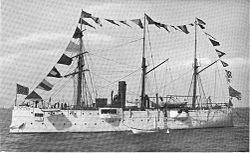Name Bancroft Commissioned 3 March 1893 Construction started 1891 Length 58 m | Laid down 1891 Decommissioned 1905 Launched 30 April 1892 | |
 | ||
Namesake George Bancroft, 17th Secretary of the Navy Builder Samuel L. Moore & Sons, Elizabethport, New Jersey | ||
USS Bancroft was a United States Navy steel gunboat, was laid down in 1891 at Elizabethport, New Jersey by Samuel L. Moore & Sons Shipyard and launched on 30 April 1892. She was commissioned on 3 March 1893 at the New York Navy Yard with Miss Mary Frances Moore as sponsor.
Contents
Naval Academy training ship
Bancroft was designated as a training ship for the United States Naval Academy midshipmen and stationed at Annapolis, Maryland. Similar in shape to a small gunboat, the ship had a steel hull and a relatively heavy armament, ranging from 4-inch rapid-fire guns to a Gatling gun and a torpedo tube, to give midshipmen experience on the Navy's latest weaponry. Between 1893 and 1896, she cruised along the east coast visiting various shipyards with groups of midshipmen embarked. Naval expansion brought a corresponding increase on the Naval Academy's enrollment, and the Bancroft quickly proved to be too small. After the practice cruise of 1896 it was converted to a conventional gunboat with a reduced armament and the original three-masted barkentine rig cut down to the two masts of a brigantine.
Patrol
On 15 September 1896, she sailed to join the European Squadron and for the next 15 months protected American interests in the eastern Mediterranean. Called home when Congress declared war upon Spain, Bancroft reached Boston, Massachusetts, on 4 April 1898 and served with the North Atlantic Squadron from 9 May–9 August. She convoyed troop transports to Cuba and was on blockade duty at Havana and the Isle of Pines. On 28 July, Bancroft seized the small schooner Ensenada de Cortez but returned the boat to her owner the next day because it was essentially valueless.
Bancroft returned to Boston on 2 September and was placed out of commission on 30 September 1898. Recommissioned on 6 October 1902, she served until 1905 as a station ship at San Juan, Puerto Rico, cruising in the West Indies and the Panama coast during the war for independence between Columbia and Panama in 1903. During 1904 she returned to patrol duties in the West Indies. On 29 January 1905 Bancroft departed San Juan, Puerto Rico and steamed for New York Navy Yard where she spent a month. On 24 February she arrived at Norfolk, Virginia where she subsequently was placed out of commission on 2 March. Bancroft was transferred to the Revenue Cutter Service on 30 June 1906, where she was renamed USRC Itasca.
School of Instruction
Itasca was refitted as a training vessel for the Revenue Cutter Service School of Instruction and commissioned 17 July 1907 where it was used for summer training cruises for the School of Instruction Corps of Cadets. Initially homeported at Curtis Bay, Maryland, she made her first summer training cruise to Europe and the Mediterranean in 1907, also visiting Puerto Rico and the Virgin Islands. In 1909 the summer cruise included ports-of-call in Spain and Italy. In 1910, the War Department vacated Fort Trumbull and Itasca was used along with her crew and students to move as much of the school as could be brought on board to the new School of Instruction location in New London, Connecticut. When she was not being used as a training ship, Itasca was assigned relief duties for other Atlantic Coast cutters requiring yard availability for repairs. After the start of World War I, cruises to Europe were suspended and the usual training cruises were interspersed with cruises that enforced the Neutrality Act in seaports along the east coast of the United States and Puerto Rico.
World War I
On 6 April 1917, the day Congress declared war on Germany, Itasca was in the harbor at San Juan, Puerto Rico and prevented the interned German ship KD-III from being scuttled by her crew. Heroic efforts by the engineer division of Itasca managed to block the sabotaged sea valves in the engine room of KD-III even though the valves were under several feet of seawater. With the flooding finally under control, there was 14 ft (4.3 m) of water in the after hold and 18 ft (5.5 m) in the forward hold. Secretary of the Navy Josephus Daniels commended the Itasca salvage team and gave the leader of the team, First Lieutenant (Eng.) Carl M. Green a special letter of commendation. With the declaration of war, Itasca was reassigned to the Fourth Naval District headquartered at Philadelphia, Pennsylvania and refit for anti-submarine service with the addition of three-inch rapid fire guns and a Y-gun for launching depth charges. She was assigned patrol duties from the southern New Jersey coast to the entrance of Delaware Bay based out of Cold Spring, New Jersey. After the armistice, Itasca returned to the academy as a training vessel, but a shortage of personnel prevented her from being manned. Her last training cruise was completed during the summer of 1920 arriving in New London on 3 October. A replacement training vessel, the former barkentine-rigged gunboat USS Vicksburg was acquired from the Navy on 1 July 1921 and renamed Alexander Hamilton on 18 August 1922. Itasca was decommissioned and sold in Baltimore, Maryland for $8250.00 on 11 May 1922 to Mr. Charles A. Jarding.
